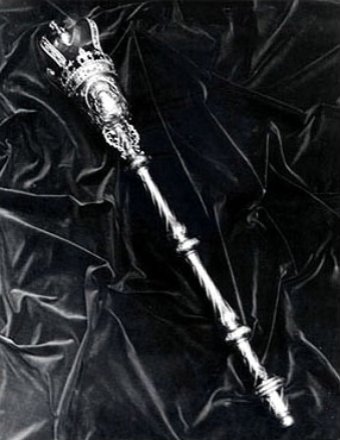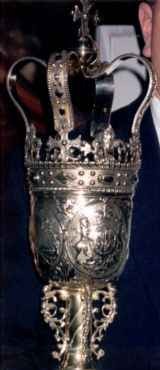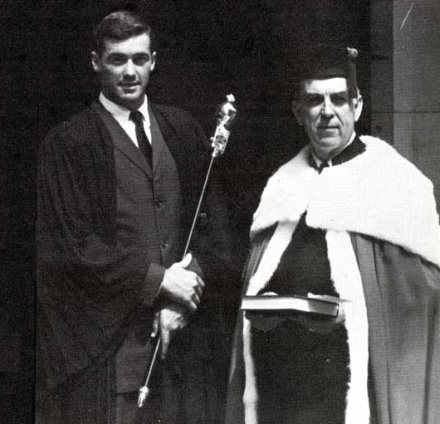Maces of America
About Andrew Cusack
 Writer, web designer, etc.; born in New York; educated in Argentina, Scotland, and South Africa; now based in London.
Writer, web designer, etc.; born in New York; educated in Argentina, Scotland, and South Africa; now based in London. read more
News
Blogs
Reviews & Periodicals
Arts & Design
World
France
Mitteleuropa
Knickerbockers
Argentina
The Levant
Africa
Cape of Good Hope
Netherlands
Scandinavia
Québec
India
Muscovy
Germany
Academica
Old Dominion, New Mace
THE HOUSE OF DELEGATES OF THE COMMONWEALTH OF VIRGINIA

VIRGINIA IS THE birthplace of Anglo-America, and as such it has managed to maintain higher standards of propriety than most other places in the States, including its long-time rival, New England. Governors, for example, still wear morning dress for their inaugurations rather than the lamentable business suit which has usurped events even so high and mighty as the inauguration of the President of the United States. (Carter abolished morning dress for the inauguration, Reagan wore it  for his first with a stroller instead of tailcoat, but since then it’s been suits all around). Roger Scruton, Britain’s greatest living Conservative thinker, recently moved with his family to Virginia to enjoy the fruits of American freedom since one of his favorite pasttimes, outlawed back in the Mother Country, thrives in his new home. The origin of Virginia’s traditional nickname, ‘the Old Dominion’, is from King Charles II who granted the Colony that title of Dominion as a recognition of its steadfast loyalty to the Crown during the trying days of the Interregnum.
for his first with a stroller instead of tailcoat, but since then it’s been suits all around). Roger Scruton, Britain’s greatest living Conservative thinker, recently moved with his family to Virginia to enjoy the fruits of American freedom since one of his favorite pasttimes, outlawed back in the Mother Country, thrives in his new home. The origin of Virginia’s traditional nickname, ‘the Old Dominion’, is from King Charles II who granted the Colony that title of Dominion as a recognition of its steadfast loyalty to the Crown during the trying days of the Interregnum.
Some traditions, however, have been mournfully discontinued. Virginia’s House of Burgesses was the first legislative body in the New World but its name was changed to the House of Delegates during the Revolution. (North Carolina, meanwhile, kept its House of Commons until it was defeated by the United States in the Civil War). Nonetheless, the House sat in the antiphonal pattern akin to the British and Commonwealth parliaments until 1904 when it adopted the dastardly French republican semicircular seating plan. To my knowledge, it was the last American legislature (outside of Canada, of course) to arrange its seating in the traditional way. (more…)
The Mace of the Palmetto State
THE HOUSE OF REPRESENTATIVES OF SOUTH CAROLINA

 The mace currently used by the lower house of the General Assembly of South Carolina is another fine example of pre-revolutionary legislative regalia. It is a reminder of tradition in a state which takes great pride in its history and heritage. Furthermore, this ancient inheritance is still in everyday use. In 1880 the tradition of the Speaker’s procession was restored and since that year every legislative day has begun with the mace being borne by the Sergeant-at-Arms of the House, followed by the Speaker. When the Speaker reaches his chair in the House chamber, he exchanges bows with the Sergeant-at-Arms, who then places the mace upon its holster before the rostrum, exchanges bows with the Speaker once more, and thence the legislative day is called to commence. Whenever the House and Senate meet in joint session, the Mace is carried at the head of the procession.
The mace currently used by the lower house of the General Assembly of South Carolina is another fine example of pre-revolutionary legislative regalia. It is a reminder of tradition in a state which takes great pride in its history and heritage. Furthermore, this ancient inheritance is still in everyday use. In 1880 the tradition of the Speaker’s procession was restored and since that year every legislative day has begun with the mace being borne by the Sergeant-at-Arms of the House, followed by the Speaker. When the Speaker reaches his chair in the House chamber, he exchanges bows with the Sergeant-at-Arms, who then places the mace upon its holster before the rostrum, exchanges bows with the Speaker once more, and thence the legislative day is called to commence. Whenever the House and Senate meet in joint session, the Mace is carried at the head of the procession.
When the House is invited by the Senate to ratify passed legislation, the Sergeant-at-Arms bears the mace before the Speaker and the Clerk of the House in a solemn procession through the corridors of the State House, across the rotunda to the Senate chamber. There, it is put in a holding place just below the Sword of State, symbol of authority in the Senate and interesting in its own right, while the Speaker of the House, the President of the Senate, and the Clerks of both houses sign the acts. (more…)
A 250-Year-Old Mace in the Old Dominion
 THE MACE OF the City of Norfolk in the Commonwealth of Virginia is believed to be the oldest civic mace in any of the United States still in use by the city for which it was made. Robert Dinwiddie, the Lieutenant Governor and Commander-in-Chief of the Dominion of Virginia, commissioned the English silversmith Fuller White to make the silver and wood mace for the City of Norfolk, at the time the largest town in the crown colony. The inscription around the base of the bowl of the Mace denotes the generous donation:
THE MACE OF the City of Norfolk in the Commonwealth of Virginia is believed to be the oldest civic mace in any of the United States still in use by the city for which it was made. Robert Dinwiddie, the Lieutenant Governor and Commander-in-Chief of the Dominion of Virginia, commissioned the English silversmith Fuller White to make the silver and wood mace for the City of Norfolk, at the time the largest town in the crown colony. The inscription around the base of the bowl of the Mace denotes the generous donation:
Despite the inscription of 1753, the mace took some time to reach the shores of America, and the minutes of the Norfolk council record the actual presentation:
Fuller White built the mace of eleven interlocking pieces of sterling silver weighing 104 ounces, which centered around a wooden rod. The Norfolk mace measures forty-one-and-a-half inches long from the very bottom of the base to the apex of the crown.
The Royal Arms, depicted in three places on the mace, most prominently outside the bowl and inside the base of the crown, are those of George II, Britain’s second German king known for his poor grasp of the English language.
In several places on the mace are depicted national emblems of George’s realm: the English rose, the Scottish thistle, the Irish harp, and the fleur-de-lis representing the claim to the throne of France still maintained — at least heraldically — at the time. (more…)
The ‘New South’ Scorns an Old Mace

George Hart, President of the Order of Gownsmen, bears the University Mace for the Vice-Chancellor, Dr. McCrady
“The recent convocation at Sewanee’s All Saints’ Chapel was a majestic display,” writes the Atlanta Journal-Constitution. “University hierarchs in medieval garb spoke Latin, their words echoing throughout the nave. New honor students donned black robes, marking their entrance into the prestigious Order of Gownsmen. Everyone sang: “Alma Mater, Sewanee, My glorious Mother ever be. (more…)
Search
Instagram: @andcusack
Click here for my Instagram photos.Most Recent Posts
- Bicycle Rack April 29, 2024
- Burns Tower April 19, 2024
- Patrick in Parliament March 18, 2024
- Articles of Note: 13 March 2024 March 13, 2024
- Cambridge March 9, 2024
Most Recent Comments
Book Wishlist
Monthly Archives
Categories


